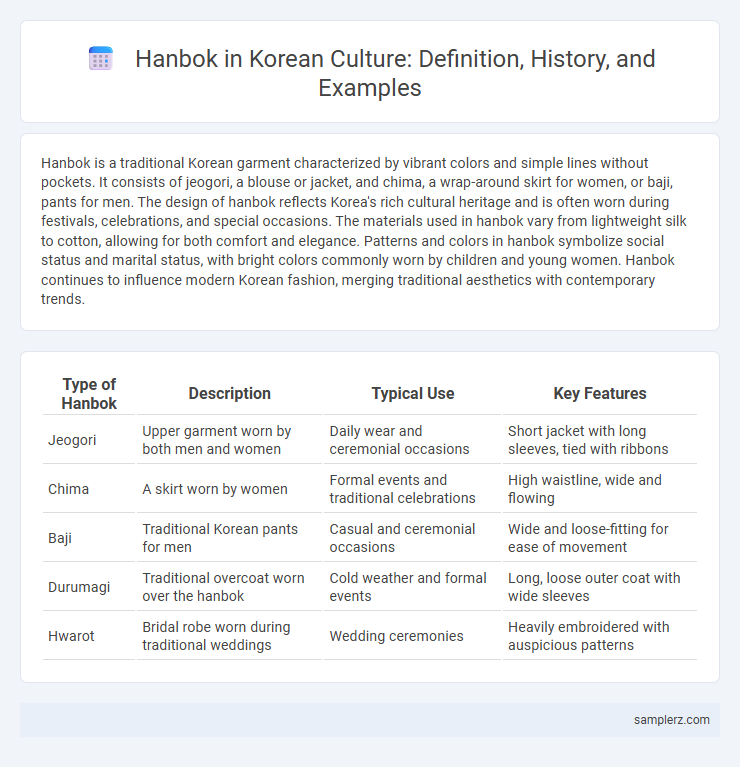Hanbok is a traditional Korean garment characterized by vibrant colors and simple lines without pockets. It consists of jeogori, a blouse or jacket, and chima, a wrap-around skirt for women, or baji, pants for men. The design of hanbok reflects Korea's rich cultural heritage and is often worn during festivals, celebrations, and special occasions. The materials used in hanbok vary from lightweight silk to cotton, allowing for both comfort and elegance. Patterns and colors in hanbok symbolize social status and marital status, with bright colors commonly worn by children and young women. Hanbok continues to influence modern Korean fashion, merging traditional aesthetics with contemporary trends.
Table of Comparison
| Type of Hanbok | Description | Typical Use | Key Features |
|---|---|---|---|
| Jeogori | Upper garment worn by both men and women | Daily wear and ceremonial occasions | Short jacket with long sleeves, tied with ribbons |
| Chima | A skirt worn by women | Formal events and traditional celebrations | High waistline, wide and flowing |
| Baji | Traditional Korean pants for men | Casual and ceremonial occasions | Wide and loose-fitting for ease of movement |
| Durumagi | Traditional overcoat worn over the hanbok | Cold weather and formal events | Long, loose outer coat with wide sleeves |
| Hwarot | Bridal robe worn during traditional weddings | Wedding ceremonies | Heavily embroidered with auspicious patterns |
Traditional Hanbok Designs in Korea
Traditional hanbok designs in Korea feature vibrant colors and elegant lines that reflect the wearer's social status and occasion. The jeogori (jacket) and chima (skirt) combination showcases intricate embroidery and silk fabrics, highlighting Korea's rich textile heritage. Hanbok styles vary by region and period, with patterns such as peonies and cranes symbolizing prosperity and longevity.
Modern Interpretations of Hanbok
Modern interpretations of hanbok combine traditional Korean garment elements with contemporary fashion trends, featuring simplified lines, lighter fabrics, and vibrant color palettes suited for everyday wear. Designers incorporate hanbok-inspired silhouettes in casual clothing and formal attire, enhancing global appreciation of Korean culture. These adaptations maintain core hanbok aesthetics while appealing to younger generations and international audiences, promoting cultural heritage through innovative design.
Hanbok for Special Occasions
Hanbok for special occasions in Korea features vibrant colors, intricate embroidery, and luxurious fabrics such as silk, symbolizing social status and celebration. Traditional designs are often customized for weddings, holidays, and cultural ceremonies, emphasizing elegance and cultural heritage. Contemporary hanbok adaptations maintain classic silhouettes while incorporating modern textile technology for comfort and durability.
Regional Variations of Hanbok Styles
Regional variations of hanbok styles in Korea reflect distinct cultural identities, with variations such as the vibrant, multi-layered Jeju hanbok characterized by lightweight fabrics suited for island living and the more structured, ornate hanbok from the Gyeonggi region known for its elegant silk and elaborate embroidery. In the southwestern Jeolla province, hanboks often feature darker colors and simpler designs, emphasizing practicality and modesty, while the northern Gangwon region incorporates heavier materials and muted tones to combat colder climates. These diverse hanbok styles highlight Korea's rich textile heritage and regional influences shaped by geography, climate, and local customs.
Celebrity Appearances in Hanbok
Hanbok, the traditional Korean attire, frequently appears in celebrity events, enhancing the cultural significance of modern occasions. Celebrities like BTS members and actress Son Ye-jin often wear hanbok during festivals and promotional events, showcasing its timeless elegance. Their appearances in hanbok contribute to global interest and appreciation of Korean heritage and fashion.
Hanbok in Korean Historical Dramas
Hanbok, the traditional Korean attire, is prominently featured in Korean historical dramas, showcasing vibrant colors and intricate embroidery that reflect the social status and personality of characters. These dramas provide a visual immersion into Joseon Dynasty fashion, where women's hanbok typically includes a jeogori (jacket) and chima (skirt), and men's attire consists of durumagi (overcoat) and baji (pants). The authentic depiction of hanbok in these series highlights Korea's rich cultural heritage and continues to influence contemporary fashion trends.
Hanbok as Everyday Wear: Contemporary Trends
Hanbok, traditionally worn during festivals and ceremonies, is increasingly embraced as everyday wear in South Korea, blending vibrant colors and modern fabrics for comfort and style. Contemporary designers incorporate sleek lines and minimalist patterns into hanbok, making it suitable for casual and professional settings while preserving cultural heritage. This trend reflects a growing appreciation for sustainable fashion and national identity among younger generations.
Symbolism and Colors in Hanbok
Hanbok, the traditional Korean attire, is rich in symbolism with colors representing social status, age, and marital status; bright hues like red and yellow symbolize joy and wealth, while blue and green convey vitality and youth. The combination of colors in hanbok not only enhances aesthetic appeal but also reflects Confucian values and nature's harmony. This color symbolism plays a significant role in Korean cultural ceremonies and festivals, emphasizing respect, celebration, and identity.
Hanbok for Weddings and Ceremonies
Hanbok for weddings and ceremonies in Korea showcases vibrant colors, intricate embroidery, and luxurious fabrics symbolizing prosperity and happiness. Traditional bridal hanbok often includes a jeogori (jacket) and chima (skirt), while grooms wear durumagi (overcoat) reflecting dignity and respect. These garments honor Korean heritage, emphasizing grace and cultural significance during important life celebrations.
Hanbok Revival in Korean Pop Culture
Hanbok, the traditional Korean garment, has experienced a significant revival in Korean pop culture through its prominent use in K-dramas and K-pop music videos, showcasing vibrant colors and modernized designs. This resurgence reflects a growing appreciation for Korea's cultural heritage among younger generations, blending historical aesthetics with contemporary fashion trends. Increased visibility in global media has further propelled hanbok as a symbol of national identity and artistic expression.

example of hanbok in Korea Infographic
 samplerz.com
samplerz.com